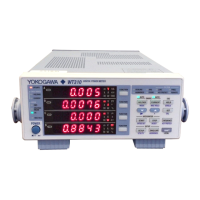2-11
IM WT310-02EN
Making Preparations for Measurements
Continuous maximum allowable input
Voltage input
Peak value of 1.5 kV or rms value of 1.0 kV, whichever is less.
Current input
Direct input
• WT310 and WT330
When the crest factor is 3: 0.5 A to 20 A
When the crest factor is 6: 0.25 A to 10 A
Peak value of 100 A or rms value of 30 A, whichever is less.
• WT310
When the crest factor is 3: 5 mA to 200 mA
When the crest factor is 6: 2.5 mA to 100 mA
Peak value of 30 A or rms value of 20 A, whichever is less.
• WT310HC
When the crest factor is 3: 1 A to 40 A
When the crest factor is 6: 0.5 A to 20 A
Peak value of 100 A or rms value of 44 A, whichever is less.
External sensor input
Peak value less than or equal to 5 times the range.
CAUTION
Use measurement cables with dielectric strengths and current capacities that are appropriate
for the voltage or current being measured.
Example: When making measurements on a current of 20 A, use copper wires that have a
conductive cross-sectional area of 4 mm
2
or greater.
Attaching a measurement cable to this product may cause radio interference in which case
the user will be required to correct the interference.
Note
• If you are measuring large currents or voltages or currents that contain high frequency components, take
special care in dealing with mutual interference and noise when you wire the cables.
• Keep measurement cables as short as possible to minimize the loss between the circuit under
measurement and the instrument.
• The thick lines on the wiring diagrams shown in sections 2.9 to 2.11 are the parts where the current flows.
Use wires that are suitable for the current levels.
• To make accurate measurements of the voltage of the circuit under measurement, connect the
measurement cable that is connected to the voltage input terminal to the circuit as closely as possible.
• To make accurate measurements, separate the measurement cables as far away from the ground wires
and the instrument’s case as possible to minimize static capacitance to the ground.
• To measure the apparent power and power factor more accurately on an unbalanced three-phase circuit,
we recommend that you use the three-voltage, three-current method (3V3A).
2.5 Precautions When Wiring the Circuit under Measurement

